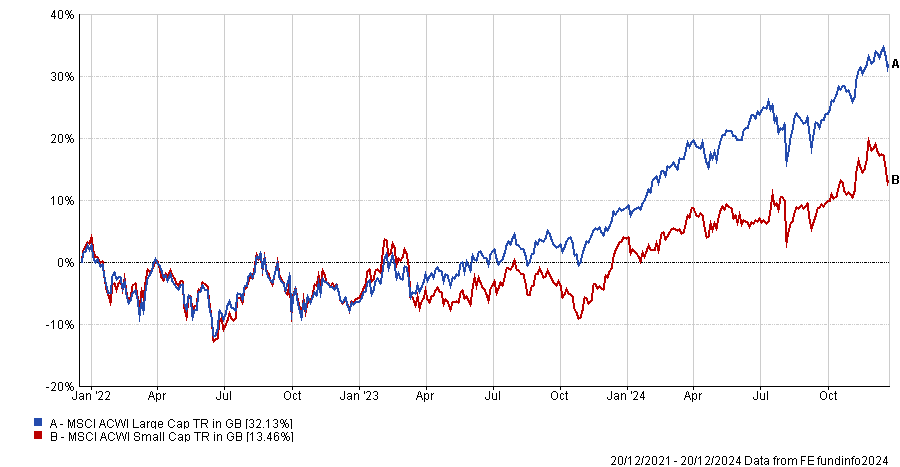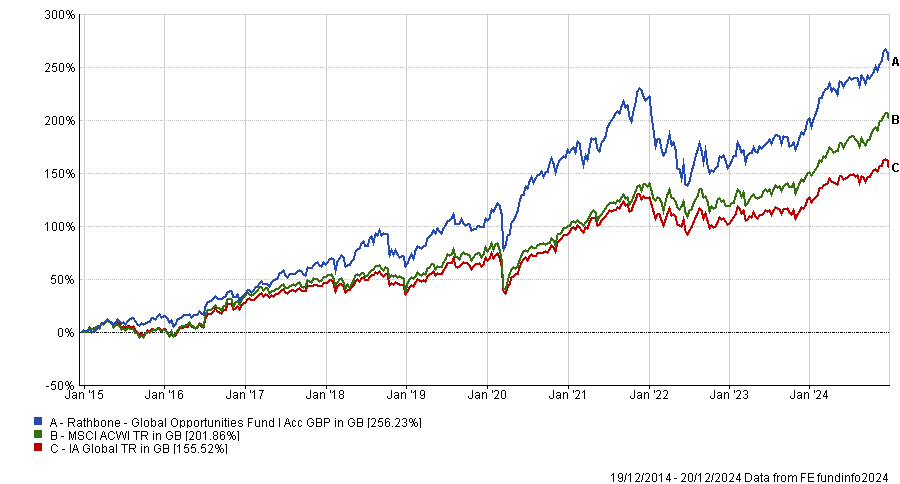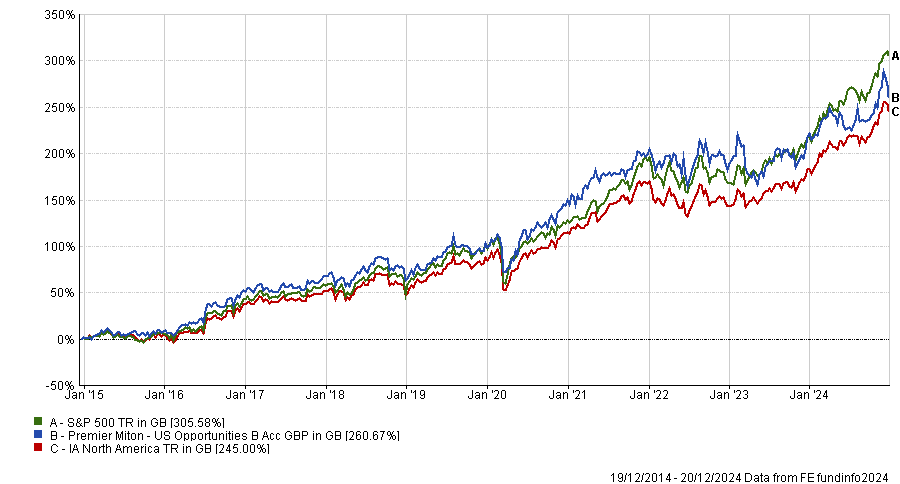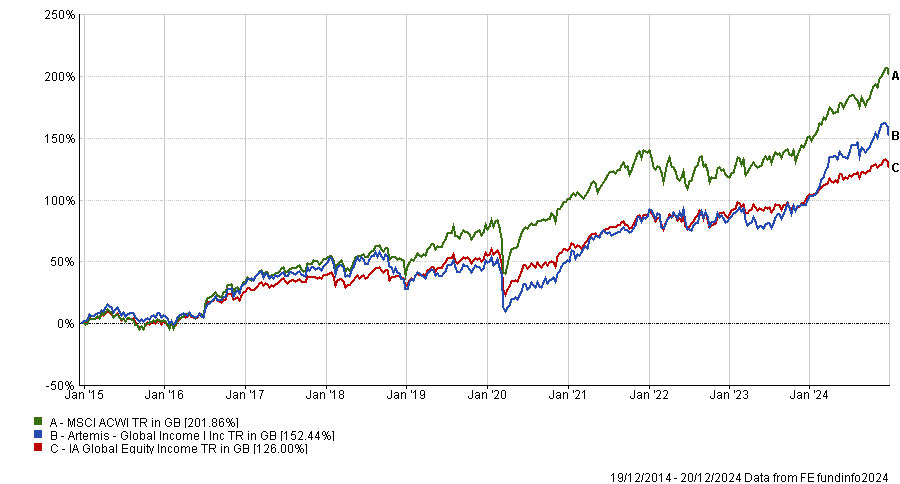Alan Ray – European Smaller Companies Trust
This year’s pick is the same as last year and the basic thesis is outlined in the article we published on Christmas Eve. As an investor it’s quite hard to love Europe, I think. The book I’ll most likely never write called “Europe: settling for second best” would be about why Europe should stop looking for the secret formula that will create a West Coast venture capital vibe on the shores of the North Sea and come to terms with its own reality. A little more of a social safety net, a few more holidays and a little bit of a quieter life.
Right now, it feels deeply uncomfortable investing in European equities, with the incoming US administration making its feelings so plain. My own view is that this could be very good for Europe as it is struggling for an identity, exposed as weak and indecisive in the face of a hot war on its doorstep and lacking the industrial might to do anything about it. A few home truths from Europe’s most important ally could, then, be just what it needs to pull itself together. One of the least polarising things one can say about the UK’s vote to leave Europe in 2016 is that the side campaigning to stay completely failed to present a positive vision of Europe, and this wasn’t just because they hired the wrong PR firm, but because, well, what exactly is that vision? Maybe we get to find out next year.
It’s of course a fantasy to think that in 12 months’ time Europe will have relaunched itself after a dressing down from the US, but stock markets are much more about the journey than the destination and right now sentiment is stuck at low tide. Even a hint that Europe is waking up to its own reality could be very good for sentiment. And after all, the quieter life that most Europeans dream of doesn’t come cheap. Something has to grow to pay for it.
In the meantime, European Smaller Companies Trust (ESCT) doesn’t really care too much about my macro meanderings and has a very impressive track record of performance that, over recent years, has kept up with or even exceeded large cap equities, no mean feat considering how far behind the small cap index is to large caps. This is achieved by taking a pragmatic view of the returns on offer from earlier stage growth companies, quality growth companies and more mature reliable companies all the way to turnaround and value situations.
And yet as outlined in the previous section, generally European smaller companies are still subject to that very wide valuation gap that has persisted for some time. Readers will no doubt be very aware that global stock market returns in the last year have been driven by the US, and within that by a few stocks. I think the idea that very large companies can’t grow fast has been completely debunked in the last 20 years, so I don’t think there’s a glaringly obvious switch out of the US on that basis, but it’s nevertheless reaching uncomfortable proportions of concentration risk, and a little bit of that risk capital could be well used taking a contrarian position in ESCT.
Alan Ray
alan@keplerpartners.com
Alan joined Kepler in October 2022. He has worked in the investment funds industry for over 25 years. The first half of his career was as an investment trust analyst, leading a highly-rated sell-side research team. More recently he has worked in corporate advisory and investment banking roles, with a focus on alternative asset classes.
David Brenchley – Fidelity China Special Situations
It’s with some trepidation that I embark on my first ever ‘top pick’ for the year. I’ve decided that the best tactic is to not be afraid of finishing stone-cold last, since that’s the most likely outcome.
Simplistically, I boiled my choice down to a momentum trade (technology to continue its ascent and verge on bubble territory) or a contrarian pick (China to bounce back aggressively). Both are tempting, but I’ll plump for the latter and go with Fidelity China Special Situations (FCSS).
I’ll first observe that there’s certainly a good chance that the technology bull market will continue to roll. The artificial intelligence-led US market boom has been replaced by the Trump trade. Corporate earnings will be boosted by tax cuts and regulation will loosen.
Still, there’s a contrarian hiding within me somewhere. Maybe that’s why only c. one-third of my portfolio’s underlying holdings are listed in the US, according to the portfolio X-ray tool on my platform AJ Bell’s website.
We’re almost four years into the Chinese bear market and I need to acknowledge that things can get worse from here, especially if POTUS-elect Donald Trump goes ahead with slapping massive tariffs on Chinese goods.
Notwithstanding that, valuations are undoubtedly cheap, with the MSCI China Index trading on a forward price-to-earnings (PE) ratio of 9.8x to the end of November. To put that in context, the forward PE on MSCI United Kingdom was 11.5x.
In addition, we’re finally seeing what seems like a concerted effort for stimulus both from the fiscal and monetary side – a powerful potential catalyst, as we’ve already seen. Markets in China and Hong Kong soared c. 40% in September, when the People’s Bank of China (PBoC) announced a package worth c. 100 trillion renminbi aimed at reinvigorating consumer confidence. The Politburo hinted that more easing measures were on their way the weekend before I write this (09/12/2024), leading to another bump in indices.
It’s by no means a buy across the board. Banks for instance look like they’re being used as a conduit to reflate consumer confidence by allowing borrowers to refinance their mortgages at artificially low rates, while parts of the property sector remains heavily indebted.
So, it’s best, then, to tap into the consumer story. Consumer confidence is currently low, largely because the country is going through a property crisis at a time when c. 50% of household wealth is in property.
Yet, China’s household savings rate stood at 31.7% in 2023, according to J.P. Morgan Economic Research. If policymakers can successfully reinflate confidence through stimulus, the more domestically focused Chinese stocks could benefit.
FCSS could be in a sweet spot, considering manager Dale Nicholls’ bias to small- and mid-cap companies, which he views as the best way to capture the growth opportunities from the increasing wealth of the Chinese consumer and to generate excess returns.
Dale is also able to invest in unlisted businesses, which can help to boost returns, as can his structural gearing, which should boost returns if Chinese shares can lift themselves off the floor.
David Brenchley
david.b@keplerpartners.com
David is an investment specialist for Kepler Trust Intelligence and joined Kepler Partners in June 2024. Before joining, he worked as money reporter for The Times and The Sunday Times where he wrote about all facets of investment for retail investors. He has previously worked for Money Observer magazine, Interactive Investor, Morningstar and Investment Week. He graduated from the University of Huddersfield with a degree in Media and Sports Journalism.
Jo Groves – Rockwood Strategic
This year’s decision was a close call between UK equities and the biotech sector, the latter benefiting from powerful growth trends such as ageing populations, game-changing obesity drugs and innovative breakthroughs in cancer therapies.
In the end, I’ve decided to stick with the UK and indeed, Rockwood Strategic (RKW) for the second year running. Some managers have described current valuations of UK small-caps as a “once in a decade” opportunity and I’m inclined to agree. However, there are undoubtedly some potential headwinds at the macro level: the Autumn Budget didn’t bring a lot of cheer for corporates and higher-for-longer interest rates could weigh on confidence and consumer spending.
On the flip side, the UK’s projected GDP growth is the third-highest among G7 nations (behind the US and Canada) and nearly double that of France and Germany. The UK also offers relative political stability (LinkedIn career histories and company phone losses aside) to its European counterparts and Trump 2.0 might just favour the UK (he hasn’t done it yet, he may do it, I’d say almost definitely).
As for stock markets, we’ve written many column inches over the last year asking when the current concentration of the Magnificent Seven will end? Maybe we’ll be writing the same thing this time next year but Ruffer’s Jasmine Yeo summed it up aptly by suggesting that they’ve “borrowed future returns” with heady valuations predicated on some pretty punchy earnings forecasts. And when this concentration of capital eventually unwinds, renewed interest in UK equities from their homegrown crowd might prove to be the long-awaited catalyst for a sustained period of outperformance.
That said, I’m hedging my bets somewhat as RKW’s strength lies in its company-specific turnaround stories, rather than needing a rising tide for UK equities. The concentrated portfolio is a higher-risk option but has historically paid off in superior returns. I’m also hopeful that M&A will provide further upside if bargain hunting by overseas and private equity buyers continues, given that RKW’s portfolio is well-positioned to capitalise on this.
Jo Groves
jo@keplerpartners.com
Jo is an investment specialist for Kepler Trust Intelligence. Prior to joining Kepler Partners, she worked as an investment writer at Forbes Advisor and The Motley Fool. Jo started her career as an auditor at Arthur Andersen, before joining the corporate finance department at Close Brothers where she advised corporate and private equity clients on acquisitions, disposals and other strategic issues. Jo has a BSc in Geography from Durham University and is a Chartered Accountant (ACA).
Josef Licsauer – JPMorgan US Smaller Companies
Looking ahead to 2025, there’s much to consider: the impact of US tariffs, Starmer’s policies in office, the pace of interest rate cuts and ongoing conflicts across Europe and the Middle East, are just a few factors likely to shape another year of uncertainty and volatility.
Yet, one can’t help resonating with what Warren Buffett has said over the years on volatility: “The true investor welcomes volatility. A wildly fluctuating market means that irrationally low prices will periodically be attached to solid businesses. It is impossible to see how the availability of such prices can be thought of as increasing the hazards for an investor who is totally free to either ignore the market or exploit its folly.”
I currently see many opportunities for investors willing to embrace uncertainty, and I’ve tried to set my sights on areas of the market where unpredictability reigns, rather than playing the 2025 top pick safe. With that in mind, my attention turns across the pond, where I believe JPMorgan US Smaller Companies (JUSC) could perform well in the year ahead.
Some may view this as a risky call, given the uncertainty surrounding Donald Trump’s tariff plan, and they wouldn’t be wrong. However, whilst tariffs aren’t usually good for growth overall, I argue they could potentially be good for US smaller companies. Trade tariffs often favour domestic businesses over international conglomerates, and smaller companies tend to be more domestically focussed, potentially positioning them to navigate this environment more effectively.
JUSC focusses on small and medium-sized companies across various sectors, with a particular emphasis on industrials. The managers target quality companies with durable franchises, strong management teams, and stable earnings, trading at discounts to their intrinsic value – an approach they argue can add stability to investor portfolios over time.
There is also currently a notable valuation gap between US small- and large-caps, with the former trading at historical lows relative to the latter. Whilst broader market factors will inevitably influence outcomes, the risk-reward profile on offer appears compelling, in my view. In the best-case scenario, US smaller companies could see a significant re-rating given their growth potential and current valuation levels. Conversely, they could struggle, but it’s hard to envisage valuations falling much further. Of course, making such predictions tempts fate but for those seeking a high-risk, high-reward strategy with differentiated US exposure beyond the Magnificent Seven, a trust like JUSC offers a strong case.
Josef Licsauer
josef@keplerpartners.com
Josef is an Investment Trust Research Analyst and joined Kepler in September 2023. Prior to this, he was an Investment Analyst at Hargreaves Lansdown, where he was responsible for fund research across a number of sectors including Japan, Europe and Alternatives. He obtained a first-class degree in Business and Management from the University of the West of England. He also holds the Investment Management certificate.
Ryan Lightfoot-Aminoff – International Biotechnology Trust
One of my biggest investing weaknesses has been a tendency to plumb for a contrarian option, when there is a much more obvious choice on offer. Sometimes, cliches are cliched for a reason. Surrey is a nice place to live, Majorca is a great holiday destination, the Germans make good cars. With that in mind, with my pick this year, I am going to do my best to play it straight, although sometimes, old habits do die hard…
Looking at the biggest drivers in the market at the moment, there seems to be no escaping the Trump trade. Putting my opinion of him and his politics to one side, he has been very clear about his plan for the economy, and that is pro-business and America first. Regrettably, that is likely to be to the detriment of… well everywhere else really. As such, my pick for 2025 is going to have a strong US tilt to it.
Looking further into some of Trump’s decisions, he has made Vivek Ramaswamy co-lead of the Department of Government Efficiency. Looking over the irony of having a second government agency (after the Government Accountability Office) to identify spending inefficiencies, Vivek is likely to use his new found power to tackle healthcare regulation. He made his billions in the pharmaceutical industry and has long railed against over regulation stymying innovation, particularly amongst small-cap biotech firms.
Taking all this into account, my pick for 2025 is International Biotechnology (IBT), managed by Ailsa Craig and Marek Poszepczynski. The vast majority of the portfolio is based in America, in line with the broader index, and the managers have a bias towards small and mid-cap companies which make up over two thirds of the portfolio, in order to tap into earlier-stage companies. On top of this, the managers can invest up to 15% in private companies which has delivered impressive returns in the past few years. M&A has been a meaningful contributor to this historically, and I believe it will continue to do so in light of potential changes to the regulatory backdrop.
The outlook for the asset class is also supported by the prospect of falling interest rates, which can weigh heavily on an industry that often requires a fair bit of financing. Furthermore, the trust itself is also trading at a wide discount to NAV, both in absolute and relative terms. The current level is c. 12%, which is close to its widest point in the past five years, despite the impressive NAV returns and arguably positive outlook.
So, whilst picking biotechnology may not exactly be a cliched decision, I believe there are so many positive factors in favour of the outlook for IBT, it makes for an obvious choice for my 2025 pick.
Ryan Lightfoot-Aminoff
Ryan@keplerpartners.com
Ryan joined Kepler in August 2022 as an investment trust research analyst. Prior to this, he spent seven years as a senior research analyst at Chelsea Financial Services where he worked on fund selection for their retail clients and on their multi-asset fund range. He holds an MSc in Finance & BA in Accounting & Finance from the University of the West of England.
Jean-Baptiste Andrieux – Fidelity Special Values
I wasn’t at Kepler last year to pick an investment trust for 2024, having only joined the team this summer—which probably saved me from some embarrassment. However, it seems I won’t escape it this year. For my debut pick, I’ll be a polite guest (as my name suggests, I’m not British) and choose a trust specialising in UK equities: Fidelity Special Values (FSV), which I recently covered (you can read the note here).
FSV’s manager, Alex Wright, invests across the entire UK market-cap spectrum with a contrarian approach, focusing on companies that may be overlooked and undervalued by the market. While seeking out stocks with low valuations, Alex ensures that there are potential catalysts for a turnaround and avoids highly leveraged companies. This approach has historically proven effective both in the short and long term, with FSV generating c. 1.6x the returns of the FTSE All-Share Index (on a NAV total return basis) over the past 10 and five years, as well as year-to-date (to 10/12/2024).
UK equities are currently trading at lower multiples than their international peers and relative to historical levels, which suggests to me that they offer a favourable risk-reward profile: in the best-case scenario, UK equities could re-rate; in the worst case, they likely won’t fall much further.
Given the risks for 2025, including potentially volatile inflation, trade tensions, and geopolitical risk, I believe cheap UK equities offer both downside protection and potential for re-rating.
Jean-Baptiste Andrieux
Jean-Baptiste@keplerpartners.com
Jean-Baptiste joined Kepler in August 2024 as an investment trust research analyst. Prior to this, he worked as a reporter for Money Marketing and Trustnet where he wrote news, features and opinion pieces. He graduated from the University of Vienna with a BA in History and from City, University of London with an MA in Newspaper Journalism. He also holds the Investment Management Certificate.












